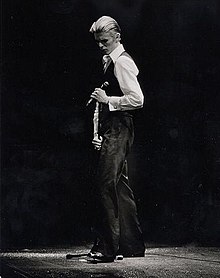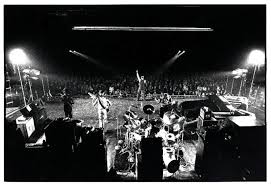Station to Station: David Bowie’s Darkest Album
April 27, 2020
The year was 1976. Two years prior, David Bowie had finished his glam-rock years with the release of Diamond Dogs, and 1975 had seen Bowie release the album Young Americans, an album he described as “plastic soul.”
However, during his 1974 tour for Diamond Dogs, something was noticeably different. The already slim Bowie now seemed skeletal. Along with this, his complexion had become a ghostly color of white. Changes even came to Bowie mentally. The once outgoing singer became very paranoid and emotional. All things considered, this was a whole new person. All these changes, both physical and mental, came from one thing: Bowie’s cocaine addiction.
Combined with managerial disputes, Bowie’s cocaine addiction eventually led to him isolating himself from others for a week after the release of Young Americans–one of the worst weeks of Bowie’s life. During this point in his life, Bowie’s diet consisted of cocaine, peppers, and milk. This added to an even more detached mental state that made Bowie obsessed with the occult. Themes that would soon turn up in his next album, Station to Station.
What emerged out of that room was no longer Bowie, but his new persona: The Thin White Duke. Similar to a character he played in the film The Man Who Fell To Earth, The Thin White Duke was described by Bowie as, “…a would-be romantic with absolutely no emotion at all…” The dark and brooding Duke was the perfect foil  to the colorful and enigmatic Ziggy Stardust. The Duke would mold the entirety of Station to Station.
to the colorful and enigmatic Ziggy Stardust. The Duke would mold the entirety of Station to Station.
Station to Station opens with the title track. Clocking in at ten minutes and eighteen seconds, it would be the longest song in Bowie’s catalogue. The opening four verses describe not only what the Duke is like, but what Bowie has become. Full of occult imagery, the arrangement makes for a depressing and mechanical tone. The next five minutes of the song are dedicated to a much more upbeat tone than its predecessor. Instead of what Bowie is now, it focuses on what he was like before his addiction with lines like, “…and once I could never be down.” Speaking of cocaine, Bowie mentions it in this part of the song with the line, “It’s not the side-effects of the cocaine
I’m thinking that it must be love.” These verses are much more detailed than what can be said in one paragraph.
Then, the album goes into its next two songs, “Golden Years” and “Word on Wing.”“Golden Years” is objectively the most upbeat song on the entire album, yet lines like “Run for the shadows” tell a different story. The song itself is almost a callback to the title track for Young Americans that contains the line, “We live for just these twenty years, do we have to die for fifty more?” The latter, “Word on a Wing” is a prayer of sorts. It feels like an actual cry for help from what little of Bowie is left. The reason it’s choked-full of religious imagery is because Bowie described this period in his life as the time when he first began thinking seriously about religion.
No doubt, Station to Station’s fourth and fifth songs are the funkiest in the album. The fourth, “TVC15,” is based on an experience where a friend of Bowie’s and fellow rocker, Iggy Pop, hallucinated that a TV had eaten his girlfriend. The second to last song on the album, “Stay,” opens up with an enticing guitar lick played by Earl Slick; the song itself deals with anxieties Bowie had been facing in light of his cocaine addiction.
“Wild is the Wind” is the sixth and final track on Station to Station. Originally made for a 1957 film, Bowie was inspired to cover it after hearing a recording by Nina Simone. Like most songs on the album, “Wild is the Wind” is special. Bowie’s voice combines a sense of romance with a sense of dread. Not only does this make for an amazing juxtaposition, but one of Bowie’s greatest vocal performances. This feeling persists through the six minute song before it erupts in a musical fury after the final verse.
As for Bowie, his cocaine addiction led to him forgetting most of Station to Station’s production. However, this would be the height of Bowie’s drug use. After the production of the album was finished, Bowie left his home in Los Angeles and spent the next few years of his life recovering in West Berlin. Here, Bowie would not only record the iconic “Berlin Trilogy” but he would produce one of his most well known songs: “Heroes.”Despite selling less than a million copies during its release, Station to Station was and will always be an outstanding album. The magazine Rolling Stone placed it on its “500 Greatest Albums of All Time” list along with other Bowie album: The Rise and Fall of Ziggy Stardust and the Spiders From Mars. While Station to Station is not held dearly in the eyes of the general public, it is beloved in the eyes of many Bowie fans.




